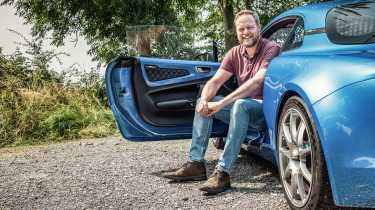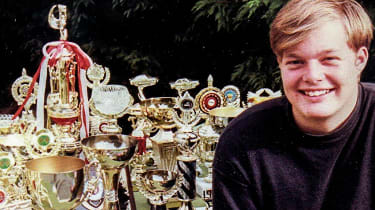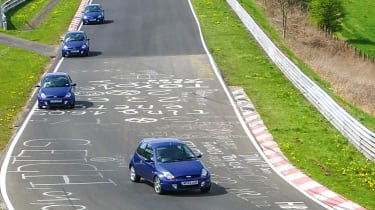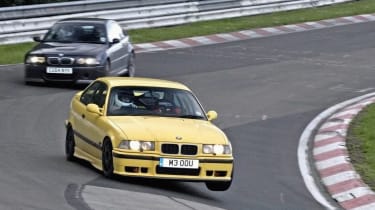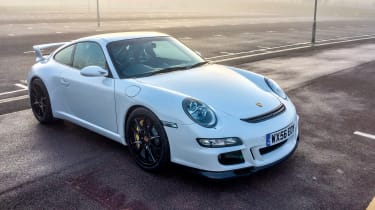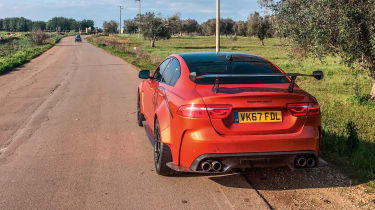My Life & Cars – David Pook, Vehicle dynamics engineer and founder of Life110
His tuned Alpine A110s have blown us away; here David Pook talks about his career highs at Jaguar Land Rover and his personal favourites among the cars that he’s owned
For 20 years a vehicle dynamics engineer for Jaguar and then Jaguar Land Rover, and more recently the founder of Life110, the Alpine A110 tuning company whose work has so impressed us, David Pook attributes at least part of his fascination with suspension and chassis behaviour to a radio-controlled car.
‘I was into suspension from an early age,’ he reveals. ‘It stemmed from my dad – an electronics engineer – bringing back a Tamiya Sand Scorcher from Japan when they first came out and building that up and seeing brilliant working suspension. It just grabbed me.’
> My Life & Cars – Jean-Pascal Dauce, Alpine chief vehicle engineer
Enthralled by the Sand Scorcher, Pook went on to race radio-controlled cars at UK regional and national level until he left school. ‘I learnt so much about suspension set-up in that time because it’s the same physics, just a tenth of the scale. The decisions you make on how you want the car to behave differently to what it’s currently doing and how you might go about that, are exactly the same.
‘I regard that as a great learning experience from the ages of 12 to 18. Fundamentally it shaped my mind into understanding how I might want a car to behave and why it might be doing one thing and not another, and then trying to make it achieve faster lap times or ride the bumps better.’
Pook’s father was also a strong influence on his choice of career. ‘My dad had a couple of Rover SD1s: we did suspension changes to one of them, Koni dampers and Spax dampers and springs. I remember him fitting an off-the-shelf kit that was just rock-hard, so he took it off and adjusted the dampers. We were on the Route Napoléon in the south of France on holiday and he was moaning about the rear damping being too soft. So he lay on the ground by the roadside with a French centime coin adjusting the Spax dampers. All of that further fuelled my interest in vehicle dynamics.’
Armed with the certainty that he wanted to work in automotive engineering, Pook set himself clear goals during secondary school and went on to take a degree in automotive engineering and design at Coventry University. ‘At the time it was an almost experimental course,’ explains Pook, ‘aimed specifically at the engineering skills required in the car industry. So there was a lot of problem-solving and learning how to design and construct components to fulfil a function.’
Meanwhile, Pook had passed his driving test. ‘My dad kindly bought me an old Mini Metro 1275, complete with 12in steel wheels, as my first car. It wasn’t long before that had a Maniflow Group N exhaust that used to wake the neighbours up, and I machined down the needle on the SU carbs, and took the manifolds off and split them, pumped the Hydragas up – I left the suspension standard. It made a lot of noise and was quite nippy.’
> Limited-run Alpine A110R Fernando Alonso revealed
Midway through university, Pook moved on to a Citroën AX GT. ‘It was one of the early ones where the body kit was in plain plastic. It was so light it was just bonkers, but stuff fell off it all the time. Still, I loved that car.’
Having done work placement with the company as part of his degree, Pook’s first job was with Daewoo: the Korean car maker had bought Worthing-based engineering consultancy IAD as the foundation for a European technical centre, so our budding suspension specialist had to decamp to the south coast.
‘Daewoo brought in a lot of experienced people to set that place up, so I learnt a lot. I was supposed to be on a graduate scheme where you worked in all the different departments, but I said “no, I’m going to do vehicle dynamics”: I must have said it so often that they gave in, and I stayed in vehicle dynamics until I left in May 2000.
‘It was a great foundation, career-wise, because it was exciting, there was lots of money at the time so you could get things done, and I was working with a good bunch of young, inexperienced people mixed in with those who very much knew what they were doing.
‘But I had a career plan, and that was that if I wanted to do vehicle dynamics at the pinnacle in the UK, I had to go to Jaguar. I didn’t apply for a job, I just wrote a “this is me, give me a job, I’d be really good” sort of letter, and that seemed to work. So I started at Jaguar in May 2000.’
Professionally, Pook was now at Jaguar, but personally he was in a Citroën ZX Volcane. ‘I had the later 2-litre version that probably wasn’t as sprightly as the earlier 1.9. I chose the Volcane because, even now, if the majority says go and buy such and such a car, my instinct is to go in the opposite direction – everyone said the Peugeot 306 was better, so I got the ZX…’
In a curious irony, the Volcane suffered death by fire caused by complications after a floodwater incident. Its successor was a Fiat Cinquecento Sporting: ‘I had it for a couple of years and managed to sell it for a 300-quid profit – that was cheap motoring!’
Meanwhile Jaguar and Land Rover had merged – though still under the Ford umbrella – and Pook was assigned, as part of a very small team, to the original Range Rover Sport project. This meant a motorway trek to Gaydon each day, a task for which the Cinquecento Sporting was ill-equipped. ‘I bought a Ford SportKa to replace it because we were working with the Ford chassis engineers and they were saying, “get a SportKa, it’s like they just bolted Puma bits to a Ka, that’s all they’ve done, it’s awesome…”.
‘So I did. And it was awesome. We could get a Ford discount, which was pretty good, so I had two of them one after the other. In vehicle dynamics four of us had them: together we once took a mini-break to the Nürburgring in them.’
Pook had arrived at Jaguar when development of the all-wheel-drive X-type was midway through, but had greater input on the front-drive derivative. He then moved on to the facelifted S-type: ‘It was called a facelift but it was a completely different car: the suspension, engines, interior – I think the only thing carried over was the bodyshell.’
Although keen to point out that vehicle dynamics is very much about teamwork – ‘the projects are too big and complicated for a single person’ – Pook is proud to have been given the lead on development of the S-type R, ‘the first one, the 4.2-litre V8 with a supercharger and Brembo brakes’. His team then moved on to the first aluminium XJ ‘that looked exactly like the old XJ but a bit bigger’.
At around the same time that development started on the second-generation XK and Jaguar showed the F-type concept car, Pook’s team became involved in a Boxster-sized mid-engined sports car project, codenamed X600. ‘It started as a joint project with Aston Martin, but Jaguar faffed around so long that Aston got fed up and did its own thing – ultimately it became front-engined and turned into the Vantage.’
It was during the X600 project – eventually canned because Jaguar needed the money for new diesel engines – that Pook witnessed an act of automotive barbarity. ‘We had six Honda NSXs as donor engineering cars and they were butchered into early-phase prototype cars – a suspension engineering car, a drivetrain car, a tyre work car…’
Outside of work, Pook had a few little projects of his own going on. ‘In the early 2000s I started building an E36 BMW M3 as a trackday car with my mate Graham, although he later had to pull out. The E36 M3 was a bit unloved at the time, but its actual ingredients were awesome. So it became my car and I took it to the Nürburgring three or four times a year and did trackdays in the UK. It had a roll-cage and bucket seat and full aero on the back, the whole shebang. Bright yellow.’
Eventually mechanical issues consigned the E36 to gather dust and Pook came up with another plan. ‘I decided I wanted an E46 M3 for a bit of fun and to commute in occasionally. Then after doing a spreadsheet calculation, I worked out that the total lifetime cost of owning this car would be cheaper if I bought an M3 CSL… I owned it for five years, did the Nürburgring, a couple of trackdays, took it to Spa. It was an awesome thing.
‘Then CSL values started to soar and I stopped using it – in my last year of ownership I only did about 700 miles in it. I ended up selling it for a very handsome profit – that wasn’t on my spreadsheet – but before then I’d bought its replacement, a Porsche Cayman R. It had only done about 20,000 miles: it had just been serviced, had new tyres, had a Porsche warranty, had an MOT, it was full-on “buy this car, put fuel in it, you won’t spend anything else, you don’t have to worry about it”.
‘To be honest I didn’t really gel with the Cayman R, it didn’t have as much sparkle as I was expecting. So I had it and the CSL at the same time and was able to afford both, which led to a bout of man maths whereby both cars equalled one Porsche 911 GT3. So I sold them both and bought a 997.1 GT3. That was just epic in so many ways. I had that for nearly two years – again, I went to the Nürburgring, did a few trackdays. But the GT3 became a lot about the fact that I had one, sort of “I’ve got a GT3, isn’t that amazing?”’
On the work front, Pook’s penchant for extreme machines led to him being assigned to more hardcore projects in an offshoot of the JLR business that was to become Specialist Vehicle Operations. ‘SVO is essentially founded on the development of the Jaguar XKR-S GT. It was a side project to take XKR-S and do something wild and wacky, and sell 50 cars to prove we could do it. It was well received and spawned a whole department: SVO.
‘It was hoped SVO would become the JLR equivalent of AMG or BMW M. First SVO project was Project 7, the F-type-based open-topped car: I took that on and ended up at SVO full-time. We grew the team to do the Jaguar and Land Rover SVR models under that banner. Project 8 was one of my favourite projects because of the freedom we had, the personal control and input I had on it, what it turned out to be, the wackiness of it, and the challenge of doing it.’
When JLR’s fortunes began to falter, in April 2019 Pook accepted voluntary redundancy and decided to set up his own engineering consultancy. As a treat he bought himself an Alpine A110, a car he reckons is the best he has ever owned and is the catalyst for his Life110 tuning business. ‘It’s a joy to go places in and it gives you character back on every journey – that’s the little miracle it provides.’
Pook seems genuinely smitten with the lightweight Alpine and is at pains only to engineer products for it that improve the dynamics, as much for himself as for his global customer base. ‘I’m consciously trying to avoid the urge to make a product for the sake of it. I’ve stayed true to the car and what I believe is the right thing for it. That approach has served me well so far.’
